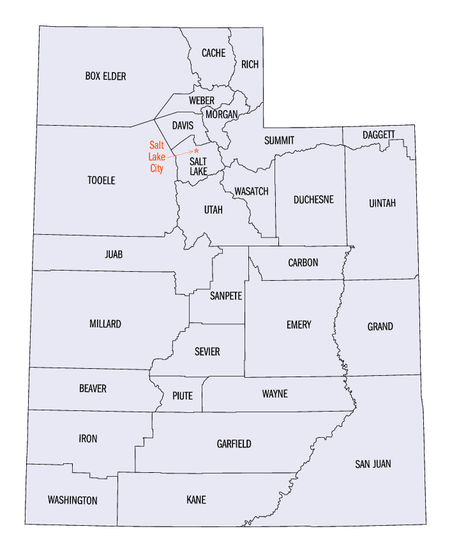Utah statistical areas
The statistical areas of the United States of America comprise the metropolitan statistical areas (MSAs),[1] the micropolitan statistical areas (μSAs),[2] and the combined statistical areas (CSAs)[3] currently defined by the United States Office of Management and Budget (OMB).
Most recently on December 1, 2009, the Office of Management and Budget defined 1067 statistical areas for the United States,[4] including one combined statistical area, five metropolitan statistical areas, and five micropolitan statistical areas in the State of Utah. The table below shows the recent population of these statistical areas and the 29 counties of Utah.

Table
The table below describes the 11 United States statistical areas and 29 counties of the State of Utah with the following information:[5]
- The combined statistical area (CSA) as designated by the OMB.[4]
- The CSA population as of April 1, 2010, as enumerated by the 2010 United States Census.[6]
- The core based statistical area (CBSA)[7] as designated by the OMB.[4]
- The CBSA population as of April 1, 2010, as enumerated by the 2010 United States Census.[6]
- The county name.[6]
- The county population as of April 1, 2010, as enumerated by the 2010 United States Census.[6]
See also
- State of Utah
- Outline of Utah
- Index of Utah-related articles
- Geography of Utah
- Demographics of Utah
- Utah counties
- Utah statistical areas
- Geography of Utah
- Demographics of the United States
References
- ↑ The United States Office of Management and Budget (OMB) defines a metropolitan statistical area (MSA) as a core based statistical area having at least one urbanized area of 50,000 or more population, plus adjacent territory that has a high degree of social and economic integration with the core as measured by commuting ties.
- ↑ The United States Office of Management and Budget (OMB) defines a micropolitan statistical area (μSA) as a core based statistical area having at least one urban cluster of at least 10,000 but less than 50,000 population, plus adjacent territory that has a high degree of social and economic integration with the core as measured by commuting ties.
- ↑ The United States Office of Management and Budget (OMB) defines a combined statistical area (CSA) as an aggregate of adjacent core based statistical areas that are linked by commuting ties.
- 1 2 3 "OMB Bulletin No. 10-02: Update of Statistical Area Definitions and Guidance on Their Uses" (PDF). United States Office of Management and Budget. December 1, 2009. Retrieved August 8, 2012.
- ↑ An out-of-state area and its population are displayed in green. An area that extends into more than one state is displayed in teal. A teal population number over a black population number show the total population versus the in-state population.
- 1 2 3 4 "American Factfinder". United States Census Bureau. Retrieved August 10, 2012.
- ↑ The United States Office of Management and Budget (OMB) defines a core based statistical area as one or more adjacent counties or county-equivalents having at least one urban cluster of at least 10,000 population, plus adjacent territory that has a high degree of social and economic integration with the core as measured by commuting ties. The core based statistical areas comprise the metropolitan statistical areas and the micropolitan statistical areas.